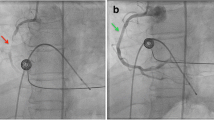Abstract.
Percutaneous transluminal balloon angioplasty for stenosis of the aorta due to aortic arteritis was attempted on 45 lesions in 41 children (age range, 4–14 years; mean, 9.9±4.2 years) presenting with symptoms of hypertension, severe congestive heart failure, and lower limb claudication. Balloon dilatation was technically successful in 38 (92.7%) patients for 41 stenotic lesions (91.1%). The mean peak systolic pressure gradient (PSG) decreased from 71.7 ± 23.9 mmHg to 23.2 ± 17.5 mmHg (p < 0.001) and the diameter of the stenosed segment increased from 3.3 ± 1.1 mm to 7.5 ± 2.2 mm (p < 0.001) immediately after angioplasty. Patients with short-segment (<3 cm) stenosis had a lower residual gradient (17.9 ± 11.1 mmHg vs 30.5 ± 22.6 mmHg; p < 0.05) and a wider diameter of the aorta (8.8 ± 1.1 mm vs 7.5 ± 2.2 mm; p < 0.02) compared to patients with long-segment (≥3 cm) stenosis. Four patients required stent implantation; 2 for flow-limiting dissection, 1 for failure to reduce PSG by >50%, and 1 for recurrent restenosis. There was marked hemodynamic and angiographic improvement in these 4 patients. Hemodynamic and angiographic restudy in 21 of the 41 patients at mean follow-up period of 6.2 ± 4.2 months (range, 3–24 months) showed restenosis in 4 (19%) patients. Restenosis was more common in patients with long-segment stenosis than those with short-segment stenosis (30% vs 9.1%). Late restudy in 8 patients, done at 3–7 years after first restudy, showed no recurrence of aortic narrowing. On clinical follow-up of 38 patients for a mean of 58.8 ± 36.0 months (range, 8–146 months) there was marked improvement in symptoms. Hypertension was cured in 11 (29%), improved in 24 (63%), and persisted in 3 (8%). Six patients with associated severe renal artery stenosis showed further improvement in hypertension after successful renal angioplasty. Severe congestive heart failure improved in 21 (95.4%) of 22 patients. Mean left ventricular ejection fraction improved from 0.32 ± 0.08 to 0.48 ± 0.10 (p < 0.001) at a mean follow-up of 28.7 ± 8.4 months in these patients. Hemodynamic restudy in 10 of these patients showed improvements in left ventricular end-diastolic pressure from a mean 37 ± 9 mmHg (range, 25–55 mmHg) to 16.4 ± 6.2 mmHg (range, 6–25 mmHg) (p < 0.001). Lower limb claudication improved in all 4 patients. Our results suggest that percutaneous transluminal balloon angioplasty in children is safe and highly effective in relieving stenosis of the aorta due to aortic arteritis, with marked clinical improvement, and should be the treatment of choice particularly for discrete stenosis.
Similar content being viewed by others
Author information
Authors and Affiliations
Rights and permissions
About this article
Cite this article
Tyagi, S., Khan, A., Kaul, U. et al. Percutaneous Transluminal Angioplasty for Stenosis of the Aorta Due to Aortic Arteritis in Children. Pediatr Cardiol 20, 404–410 (1999). https://doi.org/10.1007/s002469900501
Published:
Issue Date:
DOI: https://doi.org/10.1007/s002469900501




